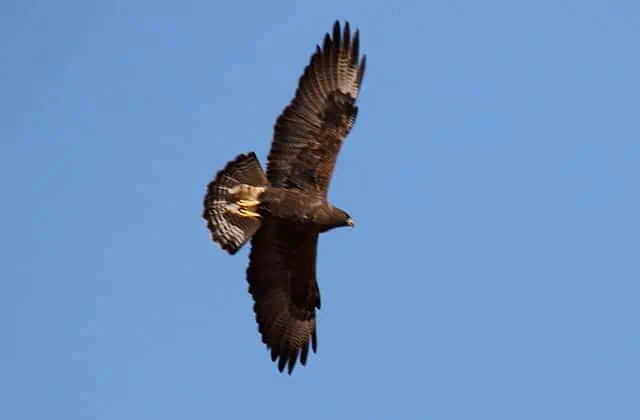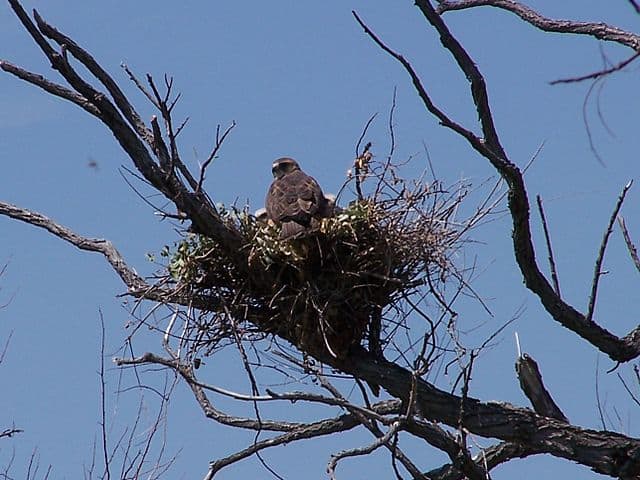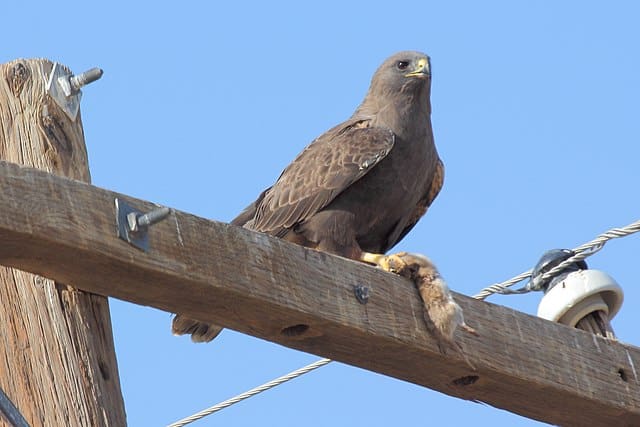- Gray Hawk Guide (Buteo plagiatus) - October 25, 2022
- Swainson’s Hawk Guide (Buteo swainsoni) - October 19, 2022
- Harris’s Hawk Guide (Parabuteo unicinctus) - September 26, 2022
The Swainson’s Hawk was not named until 1827.
In 1827, Dr. John Richardson was the first to collect a Swainson’s Hawk in Saskatchewan, Canada. Initially, it was thought to be a species of Buzzard and was given the Latin name Buteo vulgaris, which we now know as Buteo buteo (the Common Buzzard). Richardson was a British surgeon and naturalist who had accompanied Sir John Franklin, a former British Royal Navy officer, on two arctic expeditions. Based on those expeditions, Richardson produced four books called Fauna Boreali-Americana, the second of which was titled The Birds. William Swainson was a naturalist from Great Britain and a talented artist who had helped Richardson with the illustrations of the birds for the second book.
Then in 1838, Charles Lucien Bonaparte, Napoleon’s nephew, discovered it was a different species and renamed the raptor Buteo swainsoni after William Swainson. This was despite identifying it from a drawing by John James Audubon of a hawk found at Fort Vancouver in WS, and not the drawing by Swainson.
Swainson’s Hawks are a remarkable bird of prey that migrate en masse every autumn from North America to South America, a distance of more than 10,000 km. They then return for the breeding season and travel that same distance to get back!
That’s not all, though; Swainson’s Hawks migrate in huge flocks. One autumn, around 845,000 hawks were counted over Veracruz in Mexico, and another time, whilst passing over Panama City during October and November, almost 350,000 hawks were counted.
It is a birding spectacle that is not to be missed! Indeed, people from all over the world flock to these sites to witness this massive annual migration.
The Arctic Peregrine Falcon (Falco peregrinus tundrius) is the only raptor that “out-flies” Swainson’s Hawks – apparently, they can travel even further during migration. A banded peregrine falcon in the Northwest Territories of Canada was found four months later in Argentina, some 14,500 km away.
Taxonomy at a Glance
- Domain: Eukaryota
- Kingdom: Animalia
- Phylum: Chordata
- Class: Aves
- Order: Accipitriformes
- Family: Accipitridae
- Genus: Buteo
- Species: Buteo swainsoni
Swainson’s Hawks are a monotypic species, meaning there are no subspecies of Buteo swainsoni.
| Identification | Plumage variations: light, intermediate and dark morphs
Light morph – high contrast between upper (dark brown) and lower parts (whitish) Intermediate morph – less contrasting colors than light morph Dark morph – least contrast between upper and lower parts (dark all round) Rufous coloring may be present in all the morphs |
| Habitat | Prairies
Grasslands The Great Plains Western North America Adapted to agricultural land Grasslands and agricultural land in Argentina during winter |
| Diet and Feeding | When breeding: mammals like rodents
Outside breeding season: grasshoppers, caterpillars, dragonflies Sometimes called grasshopper hawk |
| Breeding | March – June |
| Nesting | In trees, just below the canopy |
| Eggs | 2 – 3 eggs most common |
| Population | Number of Swainson’s Hawks not known
Stable population |
| Endangered | Conservation status is Least Concern
Pesticide use in wintering grounds in 1990s killed large number of Swainson’s Hawks |
| Habits | Hunts and eats in flight
Also sits on the ground and runs after prey |
| Predators | Swainson’s Hawks are predators
Fratricide (eating of one’s siblings) sometimes occurs in the nests Human activity and severe weather threaten the species and their habitat |
| Lifespan | Not conclusive
Various reports from 8 years old up to 26 years old |
How to Identify a Swainson’s Hawk
Swainson’s Hawks generally have broad wings and stout bodies, but they tend to be slimmer and thinner than other North American species in the same genus of buteos. Long, narrow, pointed wings also set them apart from the other buteos.
Females look similar to males but tend to be bigger in size. A male’s length is 48 to 51 cm, and his body mass is 693 to 936 grams whereas a female’s length is 51 to 56 cm, and her body mass is 937 to 1,367 grams.
Swainson’s Hawks are polymorphic in that they have variations in plumage across the population, such as light/pale, intermediate, or dark morphs (types). I have summarized some field marks below to help identify each morph. A rufous (reddish) coloring may also be present in any of the morphs. I can see why Dr. Richardson thought the hawk he had collected in Canada was a Common Buzzard (Buteo buteo) – they tend to have variations in plumage across their population as well.
Light or pale morph:
- dark brown flight feathers and whitish wing linings (high contrast)
- dark bib between belly and chin
- lighter underparts
- gray or gray-brown tail with dark, narrow bands
- the forehead is pale
- lighter at the base of the tail and the tip, especially for the young
Intermediate morph:
- the forehead is pale like the light morph
- less contrasting colors than light or pale morph but more contrast than the dark morph
Dark morph:
- no contrast between flight feathers and wing linings like the light morph; dark all round
- breast and belly may be dark brown/grayish brown or blackish brown
- tail is darker but has the same pattern of narrow bands
As for the juveniles, their underwing pattern is the same as the adults of the same morph. The underparts are often streaked with spots, they have light cheeks and top of the head, and their backs are streaked or mottled.
Where Do Swainson’s Hawks Live: Habitat
Swainson’s Hawks favor prairies, open woodlands, grassland, and open plains such as the Great Plains and parts of western North America. They have also adapted to agricultural land in places where their habitat has changed due to human activity.
When Swainson’s Hawks migrate to Argentina in South America in the winter, they head to agricultural fields that used to be grasslands like the Great Plains. They like the alfalfa and wheat fields in particular. On their way there, they take advantage of harvested fields and grasslands for feeding and resting, perching on adjacent fence posts and power poles, for example. At night flocks roost in trees for a well-deserved rest before resuming their migration.
Swainson’s Hawk Diet and Feeding
When it is breeding time, Swainson’s Hawks eat mammals like rodents, birds, and snakes, which are also fed to their young while raising them. Their carnivore diet also helps Swainson’s Hawks store fat for the long journey south in autumn. When hunting, the hawks like elevated perches, such as tree branches, poles, fence posts, or even rocks. They also fly low over a prairie or follow farm machinery that disturb rodents for quick pickings.
Swainson’s Hawks are unique among buteos, though, because outside breeding season, they ditch the carnivore diet and eat insects like caterpillars and grasshoppers instead. It is why they are sometimes known as “grasshopper hawks”. When they are in Argentina for the winter, they mainly feast on dragonflies and grasshoppers.
Swainson’s Hawk Breeding
Swainson’s Hawks breed in their North American habitat. They commence their courtship rituals as soon as they return from their wintering grounds in early March in central California, and in April in the colder parts of North America. It is currently unknown whether the courtship starts any sooner, for instance, while they are in Argentina or during migration.
The breeding season then lasts until mid-June. Fledglings appear around July to August, depending on the location.
Swainson’s Hawk Nesting
Swainson’s Hawks build their nests in trees close to agriculture and grasslands. A male chooses the nest site though it is unknown if a female plays a role, too. The nest is built just below a tree’s canopy, so it is half-exposed.
Together a pair of Swainson’s Hawks construct or repair their nest if they return to the same one. The male does most of the work, taking up to two weeks before completion. He uses sticks, twigs, debris, and sometimes wire and rope, probably from nearby farming. For more comfort, the lining of the nest consists of fresh leaves, grass, hay, weed stalks, or bark.
Swainson’s Hawk Eggs
A female lays 1 – 4 eggs, although five eggs in a nest have been recorded. On average, the most common is 2 – 3 eggs. She also only lays one clutch per breeding season.
Incubation of the eggs is 34 – 35 days and is mainly done by the female. The male will take over if the female needs a break for feeding, to collect more material for the nest, or if she needs to preen. The male will bring the female food while she is incubating the eggs.
The first flight of the nestlings is when they are 38 – 46 days old. The young stay near the nest for up to 10 days as they still rely on adults for food. After that, they may leave, hook up and hang out with other juveniles in small groups but sometimes in groups of up to 150. Little is known about what they get up to after this point (sounds like a typical teenager!), and more study is needed – it appears they do not migrate together with their parents and instead travel independently.
Swainson’s Hawk Population
Unfortunately, it is unclear how many Swainson’s Hawks there are. As I mentioned, hundreds of thousands of Swainson’s Hawks were counted flying over specific sites in Central America, but these figures are unreliable in estimating the population. How they were measured varied, and migration numbers are not the best way to count a population.
Studies reveal that the availability of prey and nest sites tend to be the indicators for survival. For example, not enough rodents and suitable trees would cause the hawks to move elsewhere or not survive.
Red-Tailed Hawks have taken over areas where Swainson’s Hawks once were. A change in habitat may be the cause rather than competition between the two species. It is possible the habitat is no longer suitable for the Swainson’s Hawks but becomes the kind of place where Red-Tailed Hawks thrive.
Are Swainson’s Hawks Endangered?
Conservation status is rated as Least Concern. However, numbers in particular areas have fallen, and the reason is not always understood. It could be habitat changes due to human activity that has affected the population.
Also, between 1979 and 1996, the use of pesticides (monocrotophos) in Argentina caused many Swainson’s Hawks to perish. The American Bird Conservancy (ABC) actively campaigned for the pesticide to be banned after discovering the high death toll. Thankfully they were successful, and the Argentinian government banned the particular pesticide and farmers stopped using it.
Severe hailstorms in Argentina have also killed many Swainson’s Hawks. Climate change may cause more severe weather, which you can imagine could have a devastating impact on the population of Swainson’s Hawks. Because they are migratory birds of prey, there are also increasing concerns about the threat of wind turbines to the species as they fly to and from their wintering grounds.
Swainson’s Hawk Habits
Swainson’s Hawks are gregarious birds of prey. They roost in flocks in trees at night. Their flight can seem vulture-like and could cause confusion when identifying them in the sky. When soaring, the wings of Swainson’s Hawks are at a dihedral angle, just like an airplane’s wings are slightly raised upwards.
What is impressive is that Swainson’s Hawks can catch and eat insects and mammals in flight. They are also adept at hunting on the ground. They will sit on the ground and then run when they chase after prey. Their feet are well developed for this.
Swainson’s Hawks use thermals of hot air to fly to South America. As diurnal raptors, they migrate during daylight, mostly flying over land as the thermals do not tend to form over water. Groups of hawks soaring and migrating are also known as kettles. Sometimes Broad-Winged Hawks (and Turkey Vultures and Mississippi Kites) join the kettles of Swainson’s Hawks to migrate south, but they originate and winter in different places and part ways once they have reached their destination.
Swainson’s Hawk Predators
Swainson’s Hawks are predators. Top of the food chain. However, I would argue that humans threaten them in one way or another. I have mentioned habitat loss as a result of human activity already. Another threat to the hawks is an internal one: fratricide. Sibling rivalry in the nest where one of the nestlings eats all his siblings!
As Swainson’s Hawks like to roost in trees, severe weather can cause the hawks to be blown out of the trees to their death. Since the nest sites are high up in the canopy of the trees, the nests (and eggs and any nestlings) are also vulnerable to severe weather conditions like storms and high winds. Fires have been known to destroy habitat and trees for nesting, forcing the Swainson’s Hawks to roost and nest elsewhere. Heat waves in the spring can be threatening to nestlings, too.
Swainson’s Hawk Lifespan
Like the population figures, there is insufficient data on the average lifespan of Swainson’s Hawks and what is known is inconclusive. The available data shows a banded Swainson’s Hawk in Colorado lived to 18 years and two months, and another to 19 years and six months.
There is also data to suggest the oldest banded male was recorded to have been 24 years old. According to All About Birds, though, the oldest was 26 years and one month old! Other reports from Birds of the World mention an average of 8 years for birds banded and studied in the 1990s.
So it seems the lifespan of Swainson’s Hawks is anywhere between 8 years and 26 years old. That’s quite a difference.
I always find migratory birds so impressive. Imagine having to travel thousands of kilometers twice a year every year! I have not yet had the privilege to witness the spectacular migration of an entire population of Swainson’s Hawks. It would be an incredible experience to see the kettles and count the hawks as they fly over.
One for the bucket list!
FAQ
Answer: These hawks are named after William Swainson, a naturalist and talented artist from Great Britain. Swainson had drawn the hawks, which were included in the four-part Fauna Boreali-Americana in the early 19th century. Originally the hawks were given the Latin name Buteo vulgaris until Charles Lucien Bonaparte discovered it was a different species (and not a buzzard) and renamed them Buteo swainsoni to commemorate Mr. Swainson.
Answer: Yes, Swainson’s Hawks (Buteo swainsoni) migrate over 10,000 km every autumn in flocks of hundreds of thousands from North America south to Argentina. It is one of the furthest migrations a raptor will make, apparently only beaten by Arctic Peregrine Falcons (Falco peregrinus tundrius), who travel even further when they migrate.
Answer: A male Swainson’s Hawk is 48 to 51 cm, and his body mass is 693 to 936 grams. A female Swainson’s Hawk is bigger than a male: she is 51 to 56 cm, and her body mass is 937 to 1,367 grams.
Research Citations
- Bechard, M. J., C. S. Houston, J. H. Sarasola, and A. S. England (2020). Swainson’s Hawk (Buteo swainsoni), version 1.0. In Birds of the World (A. F. Poole, Editor). Cornell Lab of Ornithology, Ithaca, NY, USA.
- Newton, I. (2000) Birds of Prey. Reprint. San Francisco: Fog City Press.
- https://www.audubon.org/field-guide/bird/swainsons-hawk
- https://www.allaboutbirds.org/guide/Swainsons_Hawk
- Cambridge University Press
- https://en.wikipedia.org/wiki/John_Franklin
Looking for more interesting readings? Check out:






